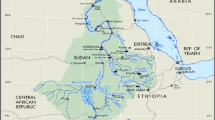Abstract
Water conflicts appear when there are insufficient and less available water resources than water demands claimed by different agents. In this study, a new bankruptcy approach is investigated to resolve water conflicts in the Zarrinehroud River Basin, the largest and most important sub-basin of Lake Urmia’s Basin in the northwest of Iran. The new bankruptcy method is compared with the proportional rule (PRO) and another alternative based on the cessation of irrigated agriculture in the region proposed to supply and save environmentally in danger Lake Urmia. Four scenarios consisting of the current situation, optimistic, average and pessimistic scenarios regarding the future of water resources of the basin and agricultural developments were considered. According to the results, both bankruptcy rules helped Lake Urmia to receive more water, but neither could utterly overcome the water shortage of the Lake, so can be used as supplementary actions alongside other solutions. The cessation of irrigated agriculture throughout the basin overcame the average annual shortage of Lake Urmia in the first and second scenarios equal to 137 and 148 million cubic meters respectively. It showed disability to fully supply the lake in the third and fourth scenarios. These three methods must be combined with a social-economic policy like the purchase of decreased water allocations to farmers to be socially acceptable.





Similar content being viewed by others
References
Abbaspour M, Nazaridoust A (2007) Determination of environmental water requirements of Lake Urmia, Iran: an ecological approach. Int J Environ Stud 64(2):161–169
Akhbari M, Grigg NS (2015) Managing water resources conflicts: modelling behavior in a decision tool. Water Resour Manag 29(14):5201–5216
Ansink E, Weikard HP (2012) Sequential sharing rules for river sharing problems. Soc Choice Welf 38:187–210
Chu Y et al (2014) Systems methodology for resolving water conflicts: the Zhanghe River water allocation dispute in China. Int J Water Resour Dev 31(1):106–119
de Vieira ZMCL, Ribeiro MMR (2010) A methodology for first- and second-order water conflicts analysis. Water Policy 12(6):851–870
Degefu DM, He W (2016) Water bankruptcy in the mighty Nile river basin. Sustainable Water Resources Management
Gholampour A et al (2015) Characterization of saline dust emission resulted from Urmia Lake drying. J Environ Health Sci Eng 13(1) p.82
Grundel S, Borm PEM, Hamers HJM (2011) A compromise stable extension of bankruptcy games: multipurpose resource allocation. (Center Discussion Paper; Vol. 2011–029). Tilburg University, Tilburg
Gunasekara NK et al (2013) Water conflict risk due to water resource availability and unequal distribution. Water Resour Manag 28(1):169–184
Herrero C, Villar A (2001) The three musketeers: four classical solutions to bankruptcy problems. Math Soc Sci 42(3):307–328
Iran’s Ministry of Energy (2013) Iran’s Water Master Plan. Technical Report of Water Resources Management Company. Tehran, Iran (in Persian)
Jury WA, Vaux HJ (2007) The emerging global water crisis: managing scarcity and conflict between water users. Adv Agron 95:1–76
Labadie JW (2005) MODSIM: river basin management decision support system. In: Singh V, Frevert D (eds) Watershed models. CRC Press, Boca Raton
Madani K, Hipel KW (2011) Non-cooperative stability definitions for strategic analysis of generic water resources conflicts. Water Resour Manag 25(8):1949–1977
Mianabadi H et al (2014) A new bankruptcy method for conflict resolution in water resources allocation. J Environ Manag 144:152–159
Mianabadi H et al (2015) Weighted bankruptcy rules and transboundary water resources allocation. Water Resour Manag 29(7):2303–2321
O’Neill B (1982) A problem of rights arbitration from the Talmud. Math Soc Sci 2(4):345–371
Perry J, Vanderklein EL (2009) Water quality: management of a natural resource. Wiley
Priscoli JD, Wolf AT (2009) Managing and transforming water conflicts. Cambridge University Press
Sechi GM, Zucca R (2014) Water resource allocation in critical scarcity conditions: a bankruptcy game approach. Water Resour Manag 29(2):541–555
Sensarma SR, Okada N (2010) Redefining the game in local water management conflict: a case study. Water Resour Manag 24(15):4307–4316
Toset HPW, Gleditsch NP, Hegre H (2000) Shared rivers and interstate conflict. Polit Geogr 19(8):971–996
van der Zaag P (2002) Towards measurable criteria for the equitable sharing of international water resources. Water Policy 4(1):19–32
Williams WD (1999) Salinisation: a major threat to water resources in the arid and semi-arid regions of the world. Lakes Reserv Res Manage 4(3–4):85–91
Wu X et al (2016) Optimizing conjunctive use of surface water and groundwater for irrigation to address human-nature water conflicts: a surrogate modeling approach. Agric Water Manag 163:380–392
Yan-ping C, Feng-ping W (2010) Evolutionary analysis of conflicts in initial water right allocation in river basin. In 2010 International Conference on Management Science & Engineering 17th Annual Conference Proceedings. IEEE, p 1918–1923
Yoffe S, Wolf AT, Giordano M (2003) Conflict and cooperation over international freshwater resources: indicarors of basins at RISR. J Am Water Resour Assoc 39(5):1109–1126
Zarezadeh M, Madani K, Morid S (2012) Resolving transboundary water conflicts: lessons learned from the Qezelozan-Sefidrood river bankruptcy problem. In: World Environmental and Water Resources Congress 2012. American Society of Civil Engineers, Reston, p 2406–2412
Acknowledgments
The authors would like to express their appreciation to the personnel of Iran’s Water Resources Management Company, specifically Seyed Morteza Mousavi, Abdolkarim Fani Hagh, Seyed Hadi Mirkiaee and Mohammad Ghasem Razmjou for their practical help, close cooperation and technical assistance. Kind acknowledgment is also directed to Sina Nabaei for his expert advice.
Author information
Authors and Affiliations
Corresponding author
Rights and permissions
About this article
Cite this article
Oftadeh, E., Shourian, M. & Saghafian, B. Evaluation of the Bankruptcy Approach for Water Resources Allocation Conflict Resolution at Basin Scale, Iran’s Lake Urmia Experience. Water Resour Manage 30, 3519–3533 (2016). https://doi.org/10.1007/s11269-016-1368-9
Received:
Accepted:
Published:
Issue Date:
DOI: https://doi.org/10.1007/s11269-016-1368-9




